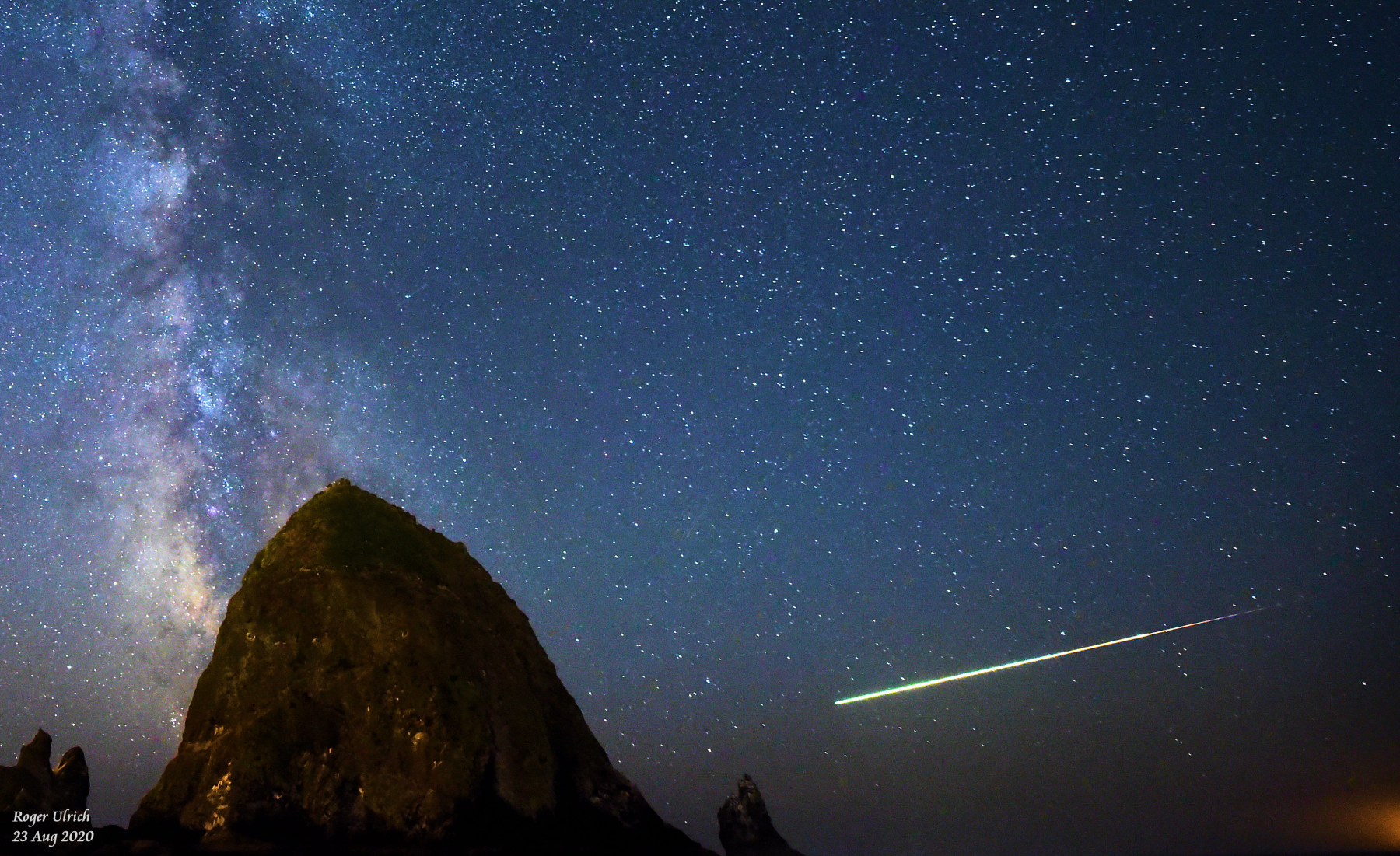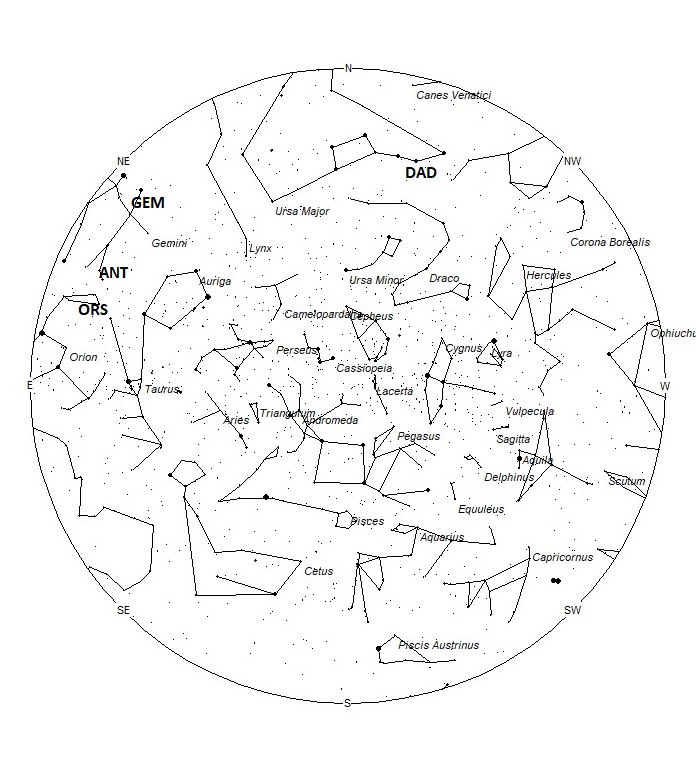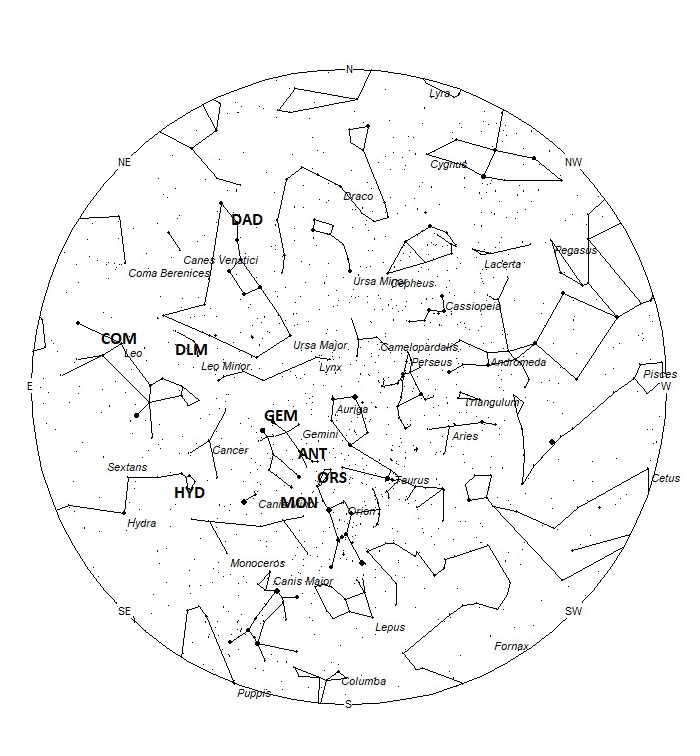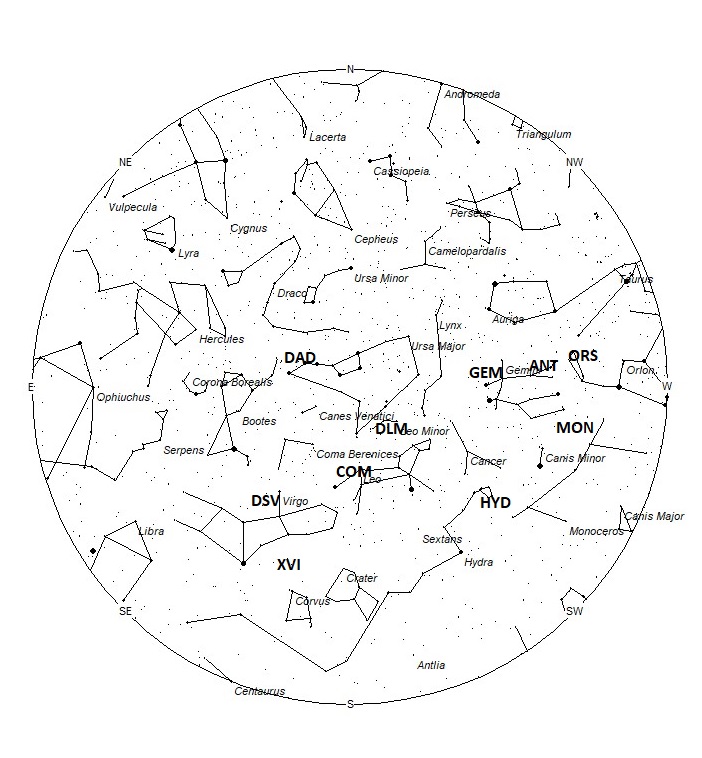 Roger Ulrich was photographing the Milky Way when this bright fireball entered the field of view. It occurred at 05:55 UT (10:55pm PDT on Aug 23) on 24 August 2020 from Cannon Beach, Oregon, USA. For more details on this particular event visit: https://fireball.amsmeteors.org/members/imo_view/event/2020/4765. Credit Roger Ulrich
Roger Ulrich was photographing the Milky Way when this bright fireball entered the field of view. It occurred at 05:55 UT (10:55pm PDT on Aug 23) on 24 August 2020 from Cannon Beach, Oregon, USA. For more details on this particular event visit: https://fireball.amsmeteors.org/members/imo_view/event/2020/4765. Credit Roger UlrichDuring this period, the moon reaches its new phase on Monday December 14th. At this time, the moon is located near the sun and will be invisible at night. This weekend the slender waning crescent moon will rise at dawn and will not interfere with viewing meteor activity. The estimated total hourly meteor rates for evening observers this week is near 6 as seen from mid-northern latitudes and 5 as seen from tropical southern locations (25S). For morning observers, the estimated total hourly rates should be near 60 as seen from mid-northern latitudes (45N) and 25 as seen from tropical southern locations (25S). The actual rates will also depend on factors such as personal light and motion perception, local weather conditions, alertness, and experience in watching meteor activity. Note that the hourly rates listed below are estimates as viewed from dark sky sites away from urban light sources. Observers viewing from urban areas will see less activity as only the brighter meteors will be visible from such locations.
The radiant (the area of the sky where meteors appear to shoot from) positions and rates listed below are exact for Saturday night/Sunday morning December 12/13. These positions do not change greatly day to day so the listed coordinates may be used during this entire period. Most star atlases (available at science stores and planetariums) will provide maps with grid lines of the celestial coordinates so that you may find out exactly where these positions are located in the sky. A planisphere or computer planetarium program is also useful in showing the sky at any time of night on any date of the year. Activity from each radiant is best seen when it is positioned highest in the sky, either due north or south along the meridian, depending on your latitude. It must be remembered that meteor activity is rarely seen at the radiant position. Rather they shoot outwards from the radiant, so it is best to center your field of view so that the radiant lies at the edge and not the center. Viewing there will allow you to easily trace the path of each meteor back to the radiant (if it is a shower member) or in another direction if it is sporadic. Meteor activity is not seen from radiants that are located far below the horizon. The positions below are listed in a west to east manner in order of right ascension (celestial longitude). The positions listed first are located further west therefore are accessible earlier in the night while those listed further down the list rise later in the night.
These sources of meteoric activity are expected to be active this week.
.
The Southern chi Orionids (ORS) have been known for about 150 years and are somewhat of a controversial listing. Many believe this is just a continuation of the Taurids into December and others feel it’s just the Anthelion source. Recent studies by Masahiro Koseki indicate that this is a separate source and should be listed separately from the Taurids/Anthelion sources. Activity is listed from November 13 through December 21, with a weak maximum on December 2nd. These meteors are known more for their fireballs than hourly rates, which seldom exceed 1 per hour. The radiant is currently located at 05:52 (088) +18. This area of the sky is located on the Taurus/Orion border, 2 degrees south of the 4th magnitude star known as Chi1 Orionis. This position is also 10 degrees north of the bright orange star known as Betelgeuse (alpha Orionis). This position is only 6 degrees southwest of the center of the Anthelion radiant so care must be taken to separate these meteors. Current rates should be less than 1 per hour no matter your location. These meteors may be seen all night long but the radiant is best placed near midnight LST when it lies on the meridian and is located highest in the sky. With an entry velocity of 25 km/sec., the average meteor from this source would be of slow velocity.
Now that the activity from particles produced by comet 2P/Encke have ceased encountering the Earth, the Taurid showers for 2020 are over and we resume reporting activity from the Anthelion (ANT) radiant. This is not a true radiant but rather activity caused by the Earth’s motion through space. As the Earth revolves around the sun it encounters particles orbiting in a pro-grade motion that are approaching their perihelion point. They all appear to be radiating from an area near the opposition point of the sun, hence the name Anthelion. These were once recorded as separate showers throughout the year, but it is now suggested to bin them into a category separate from true showers and sporadics. This radiant is a very large oval some thirty degrees wide by fifteen degrees high. Activity from this radiant can appear from more than one constellation. The position listed here is for the center of the radiant which is currently located at 06:16 (094) +23. This position lies in western Gemini, 1 degree north of the pair of 4th magnitude stars known as mu and eta Geminorum. Since the radiant is so large, Anthelion activity may also appear from southeastern Auriga, eastern Taurus, and northeastern Orion as well as Gemini. This radiant is best placed near 01:00 local standard time (LST) when it lies on the meridian and is highest in the sky. Rates at this time should be near 2 per hour as seen from the northern hemisphere and 1 per hour as seen from south of the equator. With an entry velocity of 30 km/sec., the average Anthelion meteor would be of slow velocity.
The December Monocerotids (MON) are active from December 5-20 with the peak activity occurring on December 9th. The radiant is currently located at 06:49 (102) +08. This position lies in northern Monoceros, 5 degrees south of the 3rd magnitude star known as xi Geminorum. Current rates should be near 2 per hour no matter your location. The Monocerotids are best seen near 0100 LST when the radiant lies highest above the horizon. At 41 km/sec. the Monocerotids produce mostly meteors of medium velocity.
The Geminids (GEM) are active from December 1-22, with peak activity occurring on December 14th. This weekend the radiant is located near 07:30 (112) +33. This position lies in northeastern Gemini, 2 degrees northwest of the 2nd magnitude star known as a Castor (alpha Geminorum). Rates this weekend should be near 40 per hour as seen from the northern hemisphere and 10 as seen from south of the equator. This radiant is best placed in the sky near 0200 LST, when it lies highest above the horizon. At 34 km/sec. the Geminids produce mostly meteors of medium velocity.
The Puppid-Velids (PUP) are a vast complex of weak radiants located in the constellations of Puppis and Vela. Visual plots and photographic studies have revealed many radiants in this area during November and December. The combined strength of these radiants can produce a zenith hourly rate (ZHR) of 10 in early December. Actual hourly rates will be much less unless you happen to be observing from the deep Southern Hemisphere. The center of this activity is currently located at 08:26 (127) -45. This position lies in western Vela, 2 degrees northeast of the 2nd magnitude star known as gamma Velorum. Peak rates occur near December 7. These meteors are best seen near 0300 LST when the radiant lies highest above the horizon in a dark sky. Observers located in the Southern Hemisphere have an advantage viewing this shower as the radiant will rise higher into their sky allowing more activity to be seen. Since the radiant lies low in the south for most northern hemisphere observers, meteors seen from north of the equator tend to be long in length and long-lasting. At 40 km/sec. the Puppid-Velids produce meteors of average velocity. Note: these are also listed as the “e Velids” from several sources.
The sigma Hydrids (HYD) are active from a radiant located at 08:36 (129) +02. This area of the sky is located in western Hydra, 1 degree southwest of the faint star known as sigma Hydrae in the head of the serpent. With maximum activity occurring on December 7th, current rates should be near 2 per hour no matter your location. These meteors are best seen near 0300 LST, when it lies highest above the horizon in a dark sky. With an entry velocity of 58 km/sec., the average sigma Hydrid meteor would be of swift velocity.
The December Leonis Minorids (DLM) are a shower of long duration active from December 6th through January 18th. Maximum occurs near December 17th when rates may reach 3 an hour. During this period, I would expect hourly rates of 2 as seen from the northern hemisphere and less than 1 as seen from south of the equator. The radiant is currently located at 10:20 (155) +34. This position lies in central Leo Minor, 3 degrees southwest of the 4th magnitude star known as beta Leo Minoris. These meteors are best seen near 0500 LST when the radiant lies highest above the horizon. At 63 km/sec. the December Leonis Minorids produce mostly swift meteors.
The Comae Berenicids (COM) are active from December 12-23, with maximum activity occurring on the 15th. The radiant for this source currently lies at 11:24 (171) +20. This area of the sky lies in eastern Leo, 1 degree east of the 3rd magnitude star known as Zosma (delta Leonis). This area of the sky is best placed near 06:00 LST, when the radiant lies highest in the sky. Current rates would be bear 1 per hour as seen from the northern hemisphere and less than 1 as seen from south of the equator. At 65 km/sec. the Comae Berenicids produce mostly swift meteors.
The December chi Virginids (XVI) were discovered by SonotaCo during studies of new radiants in 2008-2009. This source is active most of December with maximum occurring on December 9th. The radiant is currently located at 12:40 (190) -10, which places it in southern Virgo, 2 degrees south of the faint star known as chi Virginis. Hourly rates should be near 1 no matter your location. These meteors are best seen during the last dark hour before dawn, when the radiant lies highest above the horizon in a dark sky. At 68 km/sec. the December chi Virginids would produce mostly swift meteors.
The December sigma Virginids (DSV) is a source of long duration discovered by John Greaves using the data of SonotaCo. This source is active from November 22 through January 25. Peak rates occur near December 21st. The current radiant location is at 13:16 (199) +07 which places it in northern Virgo, 4 degrees southeast of the 3rd magnitude star known as Vindemiatrix (epsilon Virginis). Current hourly rates should be near 1 no matter your location. These meteors are best seen during the last dark hour before dawn, when the radiant lies highest above the horizon in a dark sky. At 66 km/sec. the December Sigma Virginids would produce mostly swift meteors.
The December Alpha Draconids (DAD) were discovered by the Japanese observers using data from SonotaCo. This source is active from November 30-December 15, with maximum activity occurring on December 8th. The radiant is currently located at 13:46 (206) +56. This position actually lies in northeastern Ursa Major, 2 degrees northeast of the second magnitude star known as Mizar (zeta Ursae Majoris). These meteors are best seen during the last dark hour before dawn, when the radiant lies highest above the horizon in a dark sky. This shower is not well seen from the southern hemisphere. Current rates would most likely be less than 1 per hour no matter your location. At 44 km/sec. meteors from this source would produce mostly medium velocity meteors.
As seen from the mid-northern hemisphere (45N) one would expect to see approximately 11 sporadic meteors per hour during the last hour before dawn as seen from rural observing sites. Evening rates would be near 3 per hour. As seen from the tropical southern latitudes (25S), morning rates would be near 9 per hour as seen from rural observing sites and 2 per hour during the evening hours. Locations between these two extremes would see activity between the listed figures.
The list below offers the information from above in tabular form. Rates and positions are exact for Saturday night/Sunday morning except where noted in the shower descriptions.
| SHOWER | DATE OF MAXIMUM ACTIVITY | CELESTIAL POSITION | ENTRY VELOCITY | CULMINATION | HOURLY RATE | CLASS |
| RA (RA in Deg.) DEC | Km/Sec | Local Standard Time | North-South | |||
| Southern chi Orionids (ORS) | Dec 02 | 05:52 (088) +18 | 25 | 00:00 | <1 – <1 | IV |
| Anthelion (ANT) | – | 06:16 (094) +23 | 30 | 01:00 | 2 – 1 | II |
| December Monocerotids (MON) | Dec 09 | 06:49 (102) +08 | 41 | 01:00 | 2 – 2 | II |
| Geminids (GEM) | Dec 14 | 07:30 (112) +33 | 34 | 02:00 | 40 – 10 | I |
| Puppid-Velids (PUP) | Dec 07 | 08:26 (127) -45 | 40 | 03:00 | <1 – 1 | II |
| sigma Hydrids (HYD) | Dec 07 | 08:36 (129) +02 | 58 | 03:00 | 2 – 2 | II |
| December Leonis Minorids (DLM) | Dec 17 | 10:20 (155) +34 | 63 | 04:00 | 2 – 1 | II |
| Comae Berenicids (COM) | Dec 15 | 11:24 (171) +20 | 65 | 05:00 | 1 – 1 | IV |
| December chi Virginids (XVI) | Dec 09 | 12:40 (190) -10 | 68 | 06:00 | 1 – 1 | IV |
| December Sigma Virginids (DSV) | Dec 21 | 13:16 (199) +07 | 66 | 07:00 | 1 – 1 | IV |
| December Alpha Draconids (DAD) | Dec 08 | 13:46 (206) +56 | 44 | 08:00 | <1 – <1 | IV |







 You saw something bright and fast? Like a huge shooting star? Report it: it may be a fireball.
You saw something bright and fast? Like a huge shooting star? Report it: it may be a fireball.  You counted meteors last night? Share your results with us!
You counted meteors last night? Share your results with us!  You took a photo of a meteor or fireball? You have a screenshot of your cam? Share it with us!
You took a photo of a meteor or fireball? You have a screenshot of your cam? Share it with us!  You caught a meteor or fireball on video? Share your video with us!
You caught a meteor or fireball on video? Share your video with us!
7 comments
Dear Robert!
According to the IAU, Meteor Data Center, the DLM is on the list of remote showers. The DLM is not on MDC’s work showers list. However, the DLM is on the IMO meteor calendar (working list). Please explain this.
Best regards, Ivan
Ivan and All,
Different methods of obtaining data yields different results. This IMO uses single station video while most of the others use multiple stations to obtain their data and compute their results. Juergen Rendtel and Sirko Molau of the IMO have studied DLM’s in detail and have come to the conclusion that the December Leonis Minorids are synonymous with the MDC’s Comae Berenicids. They also determined that the Comae Berenicids are a short-lived display active only in December. Since the radiant of the DLM’s actually lies in Leo Minor at maximum activity, I support listing these meteors as December Leonis Minorids instead of Comae Berenicids.
Dear Robert!
Thanks for the explanation. However, there is one point I do not understand. My hobby colleague from Minsk is engaged in video observations of meteors. So he says that such stream DLM is not in the database of streams of the program UFOOrbit, so it turns out that he will not have meteors registered as DLM. It turns out an interesting situation. For video observers the DLM stream does not exist, but for visual observers the DLM stream exists. This is some kind of strange situation. 🙂
All the best, Ivan
Ivan and All,
Ivan,
Ah, but it does exist in video databases, only the name is different. In video databases it is called the Comae Berenicids (COM) #20. Remember, that this source is currently active in Leo Minor and not Coma Berenices.
Hello all!
I will do the live stream of Geminids (from Far East of Russia, since 14:00 UT on December 13) with my camera Canon EOS 60D (on the tripod): 18 mm lens, f/3.5, 30 sec. exposure for each photos. Software: EOS Utility 2, OBS Studio.
If you are interested, you can join the viewing: https://youtube.com/watch?v=Xf4E8HuSErI
Best regards,
Filipp Romanov (amateur astronomer, IMO observer).
Hello Filipp, I am from Irkutsk Regional Astronomical Society, and we did a live stream too.
https://www.youtube.com/watch?v=SW9IEnpXF6I&t=1550s
We will be happy to cooperate with you and with all the observers.
Hi Philip! I think IMO should introduce a new method of meteor observations – virtual-visual – observations of meteors from digital media (VV-method). By the way, AAVSO has something similar. It’s called VISDIG observing method. It is observations of variable stars visually from digital photographs.